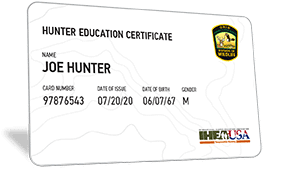
AGE REQUIREMENTS FOR OHIO HUNTERS
All first-time hunting license buyers are required to complete a state-approved Hunter Education Course before being able to purchase a hunting license within the State of Ohio. Hunter Education is required for first-time hunters who are 12 years of age or older however, there is no minimum age to get certified.

OHIO HUNTING EDUCATION REQUIREMENTS
WHAT IS AN OHIO HUNTER EDUCATION CERTIFICATE
An Ohio Hunter Education Certificate proves that you’ve obtained the knowledge needed to hunt safely, responsibly, and ethically, within the state of Ohio. All first-time hunters in Ohio are required to get certified in order to purchase a hunting license.
WHERE CAN I GET MY OHIO HUNTER EDUCATION CERTIFICATE?
Hunter Education Courses in Ohio may be complete either online or in-person, depending on preference. Many hunters choose to get certified online. Online courses typically take about 4-6 hours to complete. Upon completion of an online course, hunters will be issued a Temporary Hunter Education Certificate.
HOW OLD DO I HAVE TO BE TO GET A HUNTER EDUCATION CERTIFICATE IN OHIO?
Hunter education is required for first-time hunters who are 12 years of age or older, however there is no minimum age to get certified.
APPRENTICE HUNTING PROGRAM
Hunters who have not obtained a Hunter Education Certificate within the state of Ohio may choose to obtain an Apprentice Hunting License. The Apprentice Hunting License may be used to legally take game within the state, without hunter education, as long as the license holder is accompanied by a licensed hunter who is 21 years of age or older.
Is my Ohio Hunter Education Certificate valid in other states?
The Ohio Hunter Education Certificate will be accepted in any US state, province, or country which also requires mandatory hunter education, meaning hunters who have obtained their Ohio Hunter Education Certificate may use it to hunt in other states. This is known as “reciprocity”.
What's the difference between a Hunter Education Certificate and a Hunting License?
A Hunter Education Card proves that you’ve obtained the knowledge you need to hunt safely and ethically in Ohio, and is different from a Hunting License. The Hunting Licence is similar to a permit and is required to hunt any game animal within the state. Different licenses and permits may be required depending on which game animal is being hunted.
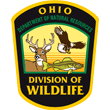
HUNTING LICENSES, STAMPS AND PERMITS
HUNTING LICENSES
A Hunting License is required in the state of Ohio to hunt any game animal. There are a variety of license types available depending on your age, residency status, and what type of game you plan to hunt. Some of the hunting license types in Ohio include:
Adult Hunting Licenses
There are various types of adult hunting licenses for hunters who wish to take game within the state of Ohio, including resident and non-resident license types. Adult Hunting Licenses for residents of Ohio may be valid for 1-10 years depending on the type of license purchased. Lifetime Adult Hunting License types are also available.
Youth Hunting Licenses
There are various types of youth hunting licenses for young hunters who wish to take game within the state of Ohio, including resident and non-resident license types. Youth Hunting Licenses for residents of Ohio may be valid for 1-10 years depending on the type of license purchased.
Senior Hunting Licenses
There are various types of youth hunting licenses for young hunters who wish to take game within the state of Ohio, including resident and non-resident license types. Senior Hunting Licenses for residents of Ohio may be valid for 1-5 years depending on the type of license purchased. Lifetime Senior License types are also available.
OHIO HUNTER CERTIFICATION AGE REQUIREMENTS

UNDER 12 YEARS OF AGE
Hunters who are less than 12 years of age who have not obtained hunter education may choose to obtain an Apprentice License. The Apprentice License permits the hunter to take game within the state, without hunter education certification. Hunters within this age group must be supervised by an adult who is 18 years of age or older.

12-17 years of age
Youth hunters who are 12-17 years of age or less must obtain hunter education certification to hunt within the state of Ohio. Hunters within this age group must also be supervised at all times while hunting by a non-hunting adult who is 18 years of age or older.

First-time Hunters
Hunters education is required for all first-time hunters, in order to purchase a hunting license within the state of Ohio. While hunter education is required for hunters who are 12 years of age or older, there is no minimum age to get certified.

Ohio's Hunting Fines

Hunting without a license or permit (minimum fine amount per-day)
Up to $250

Careless or reckless activity while hunting
Up to $500

Spotlighting or "Jacklighting"
Up to $1,500

Posessions of wild game violations
Up to $250

Taking an endangered or threatened species
Up to $1000
OHIO HUNTING FAQS
DO I NEED A HUNTING LICENSE TO HUNT WITHIN THE STATE OF OHIO?
Yes. A Hunting License is different from a Hunter Education Certificate and is required for any person who hunts any game animal within the state. This includes both residents and non-residents. Varying licenses must be purchased and carried depending on the hunter’s age, residency, and the type of game being hunted. Certain exceptions may apply depending on the game animal being hunted. For more information on Ohio hunting licenses visit the Ohio DNR Wildlife Division website.
WHAT ARE THE OHIO TAGGING REQUIREMENTS?
Certain game animals must be tagged after they’re taken, including big game animals such as deer and turkey. It’s important for hunters to understand the tagging and/or harvest reporting requirements for the game animal they’re hunting, and to ensure that the animal is tagged and reported properly.
Tagging Requirements
Hunters who harvest deer or turkey within the state of Ohio must create their own game tags to properly tag their taken game animal. The state recommends that hunters protect the tag by placing it in a plastic bag or waterproof pouch before and after being attached to the game animal.
The animal must be tagged immediately after being taken. The tag must be marked with the hunter’s name, date, time, and county where the game was taken. The deer or turkey permit must also be marked with the date, time, and county of the kill.
Once the animal has been properly tagged, it can be transported out of the hunting area.
Game Check Requirements
Hunters must also report their deer and turkey harvest using Ohio’s Game Check system. Hunter’s may report their harvest online, by phone or by visiting any authorized license sales agent.
To access the Game Check System online visit the Ohio Department of Natural Resources Division of Wildlife website. To report by phone call 1-877-824-4864. Deer that have been harvested must be reported by noon the day after the animal was taken. Turkey must be reported by 11:30 pm on the day of the kill.
WHAT ARE THE HUNTER ORANGE REQUIREMENTS IN OHIO?
Hunters who take game within the state of Ohio are required to wear a vest, coat, jacket, or coveralls, that are either solid orange or camouflage hunter orange. These requirements apply to any hunter taking game (except waterfowl) for 30 minutes before sunrise to 30 minutes after sunset, during the youth deer gun season, deer gun season, and deer muzzleloader season. The requirements apply on both public and private land.
WHAT ARE THE BAG LIMITS IN OHIO?
Bag limits are imposed on hunters to restrict the number of a particular game animal that can be taken. Bag limits may be daily or seasonal depending on the type of animal. For example, in Ohio daily bag limits are imposed which restrict the number of a particular game animal that can be taken within a hunting day. Seasonal bag limits restrict the number of a particular game animal that may be taken by a hunter within the hunting season.
Bag limits may vary annually depending on game species populations. Hunters must understand and follow bag limit restrictions. Violations may result in fines. For more information on bag limits visit the Ohio DNR Division of Wildlife.

GAME AND NON-GAME SPECIES
GAME SPECIES
Ohio offers a wide variety of game species for all types of hunters. The state’s varied landscape results in a variety of habitats and ecosystems which are home to big and small game, waterfowl, and a variety of furbearers. Some of the game species in Ohio include:
- Big game including white-tailed deer and turkey.
- Small game including squirrel, grouse, rabbit, quail, and groundhog.
- Waterfowl and other migratory game birds including ducks, geese, and mourning dove.
- Furbearers including otter, beaver, mink, fox, raccoon, and opossum, among others.
NON-GAME SPECIES
Nongame species within Ohio make up a significant number of the state’s wildlife populations and include mammals, birds, fish, reptiles, amphibians, and invertebrates which typically may not be hunted, are considered a nuisance, or are protected, endangered, or at risk. There is, unfortunately, a lengthy list of endangered, protected, and threatened species within the state. For more information on nongame, and endangered species within the state visit The Nature Conservancy website. Nongame species within Ohio make up a significant number of the state’s wildlife populations and include mammals, birds, fish, reptiles, amphibians, and invertebrates which typically may not be hunted, are considered a nuisance, or are protected, endangered, or at risk. There is, unfortunately, a lengthy list of endangered, protected, and threatened species within the state. For more information on nongame, and endangered species within the state visit The Nature Conservancy website.
INVASIVE SPECIES
Invasive animals and other pests have been introduced to the United States, including the State or Ohio, and have become a threat to native wildlife. These animals, plants, fish, and invertebrates typically have no natural predators which can result in rapid spread and population growth. This in turn can seriously harm the state’s lands and waters, and can be detrimental to the health and population numbers of a variety of the state’s native plants and animals. Some common invasive species in Ohio include the emerald ash borer and asian long horned beetle, among many others..
In order to protect Ohio’s native plants and animals, invasive species must be controlled and eradicated. Anyone who encounters or suspects that they have encountered an invasive species within the state is encouraged to report the sighting so that it can be monitored and controlled. For information on how to report various types of invasive species in Ohio visit the Ohio Forest Association Website.

OHIO HUNTING SEASONS
Hunting seasons and dates may change annually per game animal, depending on a variety of factors. Season dates may be further broken out region, county or”zone”. Additionally, seasons are often categorized by firearm time, including archery, firearms, and muzzleloader or “primitive” firearms seasons.
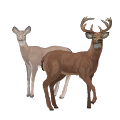
White-tailed Deer
Deer seasons in Ohio are organized by firearm type including a gun, archery, and muzzleloader season, in addition to a youth season. White-tailed deer season typically begins in September with the archery season and ends in January of the following year with the muzzleloader season.
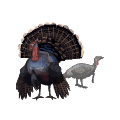
Turkey
Turkey seasons in Ohio are organized by zone, and include both spring and fall seasons. Spring season typically opens in late April and closes and late May, while the fall season opens in October and closes in November.
Learn more about hunting turkey in Ohio.
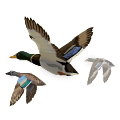
Waterfowl
Waterfowl season dates are organized by “zone”, and dates vary depending on the species. Early seasons dates typically begin in September, with later seasons closing as late as January of the following calendar year.

Small Game
There are several small game animals to hunt in Ohio crow, squirrel, rabbit, pheasant and quail among others. Seasons dates for small game types vary depending on the game animal type. Early seasons typically begin in October with later seasons dates ending as late as March of the following calendar year.
HUNTING ON PUBLIC OR PRIVATE LAND
PRIVATE LAND
Much of the land in Ohio is privately owned. Hunters can typically freely take game animals hunted on their own private property, or may seek permission from a landowner to hunt on private property. Hunters who wish to take game on privately owned land must follow state hunting regulations as well as any regulations specified by the landowner. Hunters must ensure they respect the rights and property of the landowner at all times.
PUBLIC LAND
Some of Ohio’s best hunting opportunities can be found on public lands within the state within numerous state Wildlife Areas. Hunters may also find opportunities within one of the states many state parks and forests. The purpose of the state-owned land is to provide management of wildlife and habitat and to provide hunting and trapping opportunities for hunters.
State-managed lands may have specific rules and regulations in place that must be followed by all land users. State lands may also be used for other recreational purposes including horseback riding, snowmobiling, and bicycling.
For more information on the rules and regulations that apply to hunters and other recreational users of state lands, visit the Ohio Department of Natural Resources website.
Wildlife Management Areas
Hunting in Ohio’s Wildlife Management Areas
Wildlife Areas (WMAs) in Ohio are designated as public lands that are state-owned and operated by the Ohio Department of Natural Resources. There are more than 100 Wildlife Areas in the state of Ohio, encompassing hundreds of thousands of acres of forests, grasslands, and wetlands, and other natural areas. These spaces are open to hunting and other types of outdoor recreational activities.
WMA Regulations
Additional rules, regulations and restrictions may apply when hunting in Wildlife Areas or using them for other recreational purposes. Regulations will typically be posted within the area, and may vary depending on the Wildlife Area you’re accessing. Some of these regulations may include:
- Firearm type restrictions and take method restrictions
- Restrictions on training dogs for hunting purposes
- Restrictions on motor vehicle access
WMA Permits
There are no specific additional permits required to hunt within Wildlife Management Areas (WMAs) in Ohio. However, hunters must obtain the required licenses to take the game species they plan to hunt.
The Buckeye State. Ready and rarin’ to go.

Where to Hunt in Ohio
There are plenty of game animals and opportunities for hunters in Ohio, in addition to millions of acres of private land and public land open to hunting. Deer hunters should focus their efforts on the Central and Southern regions of the state, including Coshocton County which features the Woodbury Wildlife Area, Tuscarawas County which offers plenty of private land, and the Beach City Wildlife Area, and Greene County which still holds the Pope & Young world record for a non-typical white-tailed buck.
Doves are another of Ohio’s popular game species – and there are doves-a-plenty throughout many regions of the state. Open season for dove is also typically one of the earliest (beginning in September). So if you’ve been counting the days until you can dust off your shotgun and gear, doves are a great choice. To find your feathered prey, head north-west to Williams County and the Lake La Su An Wildlife Area – this region of the State features plenty of ideal dove habitat and biologist-planted food plots making it a hot spot for doves